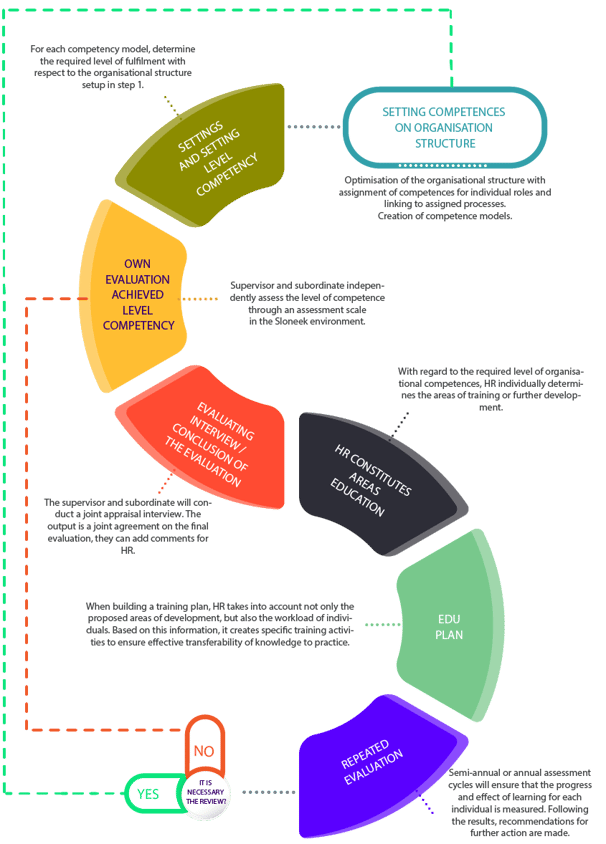Inspiration for building and evaluating skill sets / competency models
We know what you will face when building and evaluating skills (competencies). Our experience can inspire you.
What do you find in this article?
Why and how to start managing through skills / competencies
This way of managing brings order, clarity, efficiency, savings, increased motivation and, last but not least, joy to the corporate environment.
Why do we use alternatives such as skills or abilities as equivalent to the term COMPETENCY?
Often, in all languages, the subtle nuances in the term Competency itself are blurred. Skills / Skills are more commonly used and better understood (though not exactly). Moreover, some languages has two different meanings for the same word:
- competence as an expression of the power to do something, to decide
- competency as the sum of knowledge, skills, experience and attitudes of people who work for you (or could work for you)
And it is the latter term that is at issue here. So it is not the intention to confuse, but to approach, explain and teach the use of the correct form.
We’ve put together an e-Book that takes you through competency-based management in real detail and in a condensed view. With tips, tricks, checklists. You can download it HERE.
How to build competency models / skill sets
There are different approaches. In practice, we highly recommend avoiding the assessment of non-talking or all-encompassing competences such as communication or presentation skills.These are very broad topics and it is more appropriate to select the part that is key for the role. For example, presenting to an audience of more than 100 people or Establishing relationships with key stakeholders, initiating and leading meetings with clear outcomes. Thus, these are specific behaviours/skills that are key to the specific role and should be evaluated and developed.
But if you are still going to use these simplistic terms, take great care to describe the assessment scale well!
💡Remember that there is no one-size-fits-all solution. Every business is a little different and so each will need a slightly different setup.
A good inspiration and to some extent a guide for formulation is to use the OECD competency framework. It will help you get oriented quickly, soak up inspiration and help with formulations.
❗ WARNING: do not be seduced by the fact that the competencies in the database are ready-made for the position. Carefully consider their exact take-up. See them as inspiration, not as one source of true❗
Setting up the assessment scale
As with the competencies themselves, the scales are highly individualisable. Which ones do we use in practice?
YES / NO (boolean) – particularly useful for assessing hard competences. Use it where we do not assess any “in-between”.
Polarity assessment – a more abstract form of assessment. Assess whether the current state of the competency is closer to the undesirable manifestation represented by the value “0” or closer to “100”.
Scale Description Assessment – We describe the scale values (e.g. 0-5) precisely to make it clear what each level represents. We use 2 approaches here:
- Example 1: Sets realistic and relevant goals. Can plan.
-
- 0 – Disagrees
- 1 – Rarely
- 2 – When the opportunity arises
- 3 – Only when making a big effort
- 4 – Often
- Example 2: Effective communication
- 0 – Formulation of ideas in both written and oral form is very difficult, ability to listen to others is limited, communication of information to others is haphazard, sporadic and fragmented
- 1 – has difficulty formulating ideas, especially in written form, has difficulty listening, passes information to others only on request, cannot predict his/her reactions to unexpected situations
- 2 – in normal situations, he/she formulates his/her thoughts clearly and comprehensibly both in spoken and written form, listens to others without much difficulty, shares information, reacts appropriately to the situation, his/her communication is not always convincing
- 3 – articulates his/her ideas clearly and comprehensibly both in spoken and written form, listens to others, responds assertively to the situation, is able to engage others with his/her speech, tolerates the opinions of others
- 4 – formulates ideas both in written and oral form at a very good level, actively listens to others, healthy and appropriate self-presentation is natural for him/her, can present in front of a group, can open communication, creates an environment for others to communicate, welcomes and develops others’ opinions, can provoke constructive conflict, requires feedback
- 5 – articulates ideas in written and oral form is at an excellent level, practices active listening without exception at all times, healthy and appropriate self-advocacy is natural to him/her, can present in a large forum and persuade others with his/her speech, can elicit and work with others’ real opinions, can use constructive conflict, can work with feedback, communicates with other cultures.
For the second example, pay close attention to a clear definition and good reasoning of the required behaviour / knowledge. It can easily happen that the speech described does not capture the clear essence of the competency needed to perform the role.
The process of developing and assessing competences in the company




